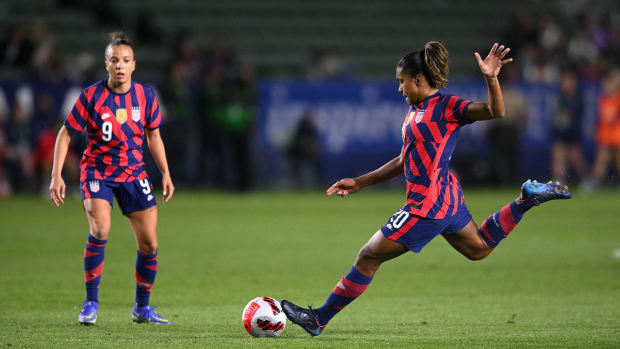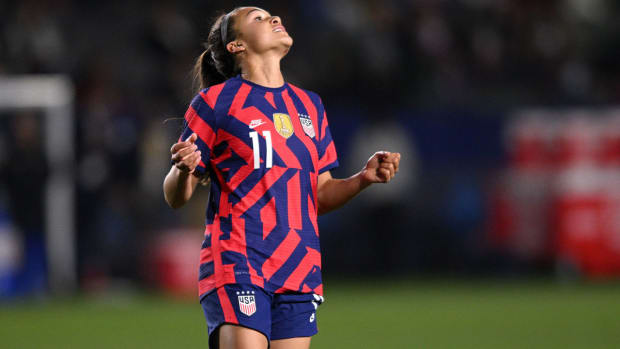Short-term results may be sacrificed for a more fruitful long-term future, and that's a price the U.S. appears to be willing to pay.
Such is the standard that the U.S. women's national team has carried through its many iterations over the last three decades, that a puzzling result might be cause to sound a light alarm—even if it's all part of a greater plan.
Thursday night's SheBelieves Cup opener is a case in point. Coach Vlatko Andonovski has been clear about his desire to bring along a new wave of talent, and taking a long view means that the results in the short term could be collateral damage. A 0–0 draw against the 24th-ranked Czech Republic, for instance, doesn't do much to inspire confidence when the expectation, regardless of who is on the field, is a win by any means necessary. This is a down year for the SheBelieves Cup in terms of the strength of the field (Iceland, New Zealand and Czech Republic are not quite on the same level as past participants France, Brazil, Japan, Canada, Germany and England), but the same can be said about the squad the U.S. has brought to the competition.
Stating the obvious, the U.S. looks a lot differently when the likes of Alex Morgan, Christen Press, Tobin Heath, Megan Rapinoe, Sam Mewis, Julie Ertz, Crystal Dunn, Lindsey Horan and Abby Dahlkemper (seven of those nine started the 2019 Women's World Cup final; Press came off the bench) are not involved. As it was, the average age for the U.S. lineup Thursday night (25.5) was its youngest in almost four years, and the caveats go beyond just that. Despite the multiple U.S. camps during the NWSL offseason, it's still preseason for this entire group except Lyon's Catarina Macario, who, unsurprisingly, was one of the brightest spots in the attack and had her chances to score.

Orlando Ramirez/USA TODAY Sports
But this team and the crafting of its next iteration, for which expectations will once again be global domination, is a work in progress.
"I wouldn't say chemistry is lacking. You look at the players that were on the field, how many times they’ve been on the field together, that’s something that will come with the minutes and games together," Andonovski said. "It doesn’t matter how good they are or how much potential they have. It’s not easy to throw them on the field and expect them to click immediately."
The way the next 17 months are structured allows Andonovski to operate with that long view. The goal is not winning the SheBelieves Cup, it's three-peating at the Women's World Cup. Between now and July 2023, there's a considerable runway for the "minutes and games together" to increase exponentially. And the veterans who are not part of this competition are by no means out of the picture. Andonovski has made it clear that they do need to earn their way back through their play in the upcoming NWSL season, but it's been the plan all along to give some greener players a chance at experiencing the spotlight so that they are more prepared for a more permanent transition.
It's not as if the current group is completely devoid of experience, either. On Thursday, captain Becky Sauerbrunn became the 12th U.S. player to earn her 200th cap, while Kelley O'Hara hit 149, for instance. But on the other end of that spectrum is someone like Trinity Rodman, the supremely talented 19-year-old Washington Spirit forward who earned the first of what should be many caps after coming off the bench in the second half.
"I just think this is a first of many for her. She definitely needs more minutes, more caps, more games, and I have no doubt that she's going to perform even better," Andonovski said.
The blending of old and new, experienced and wide-eyed—that is the more immediate goal.
"Right now in this camp I want to give a chance to players like Sophia Smith and Mal Pugh and Catarina Macario, Ashley Hatch, players who have earned their spots or earned their spots back on the national team," Andonovski said upon his roster release for the competition. "I want to give them maximum minutes so we can evaluate every aspect of their game."

Orlando Ramirez/USA TODAY Sports
Those evaluations will go a long way in determining who will take part in World Cup qualifying this summer. The new qualifying format—and expanded World Cup field to 32 for the 2023 competition in New Zealand and Australia—means that, realistically speaking, it would take utter catastrophe for the U.S. to not book a trip down under. Four Concacaf teams, up from the previous two automatic berths and one intercontinental playoff spot, will make up an eighth of the field, and they'll be cemented as part of July's Concacaf W Championship, which doubles as qualifying for the ’24 Olympics as well.
Between now and then, strides certainly need to be made—especially in the final third, where the U.S. struggled to come up with the scoring touch that has been a hallmark of this team for ages. While the breakthrough never came Thursday night against a Czech side that has held the powerful Netherlands to a pair of draws in World Cup qualifying in the last five months, the foundation is being set. If more immediate results are sacrificed for a more fruitful long-term outlook, that's a price the U.S. appears to be willing to pay, especially on the heels of a bronze medal showing at the Olympics with a team that, at times, looked in need of a refresh.
“I’m happy with where they’re at right now,” Andonovski said. “But we all know that how we look and where we're at is nowhere near enough to win big games.”
More Soccer Coverage: